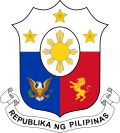
Back رئيس الفلبين Arabic Presidente de Filipines AST Filippin Prezidenti Azerbaijani Presidente kan Filipinas BCL Президент на Филипините Bulgarian Pamuno-Nasod sa Pilipinas CEB سەرۆک کۆماری فلیپین CKB Präsident der Philippinen German Πρόεδρος των Φιλιππίνων Greek Presidente de Filipinas Spanish
| President of the Philippines | |
|---|---|
| Pangulo ng Filipinas | |
 | |
 | |
since June 30, 2022 | |
| Government of the Philippines Office of the President | |
| Style |
|
| Type | Head of state Head of government Commander-in-chief |
| Member of | Cabinet National Security Council |
| Residence | Malacañang Palace |
| Seat | San Miguel, Manila, Philippines |
| Appointer | Direct popular vote or by succession from vice presidency |
| Term length | Six years, non renewable |
| Constituting instrument | Constitution of the Philippines (1987) |
| Precursor | Governor-General Prime Minister[a] |
| Inaugural holder | Emilio Aguinaldo (official)[b] Manuel L. Quezon (official)[c] |
| Formation | 23 January 1899 (Republic; official)[1][b] 15 November 1935 (Commonwealth; official)[2][c] |
| First holder | Emilio Aguinaldo |
| Salary | ₱411,382/US$ 7,409 per month[d][3][4][5][6] |
| Website | president.gov.ph (former website) op-proper pbbm |
 |
|---|
|
|
The president of the Philippines (Filipino: pangulo ng Pilipinas, sometimes referred to as presidente ng Pilipinas) is the head of state, head of government and chief executive of the Philippines. The president leads the executive branch of the Philippine government and is the commander-in-chief of the Armed Forces of the Philippines.
The president is directly elected by the citizens of the Philippines and is one of only two nationally elected executive officials, the other being the vice president of the Philippines. However, four vice presidents have assumed the presidency without having been elected to the office, by virtue of a president's intra-term death or resignation.[e]
Filipinos generally refer to their president as pangulo or presidente in their local language. The president is limited to a single six-year term. According to Article 7 Section 4 of the Philippine 1987 Constitution, the president "shall not be eligible for any reelection" and that, "no person who has succeeded as president and has served as such for more than four years shall be qualified for election to the same office at any time" Although Gloria Arroyo served as president for 9 years 5 months and 29 days [7] from 2001–2004, after taking over the office of President Joseph Estrada as he was forced to stepdown as President of the Philippines,[8] to 2004–2010 when she served as the elected as President of the Philippine Republic.[9]
The current president of the Philippines is Bongbong Marcos, who was sworn in on June 30, 2022, at the National Museum of Fine Arts (formerly the Legislative Building).
Cite error: There are <ref group=lower-alpha> tags or {{efn}} templates on this page, but the references will not show without a {{reflist|group=lower-alpha}} template or {{notelist}} template (see the help page).
- ^ "Emilio Aguinaldo". Official Gazette of the Philippine Government. March 22, 2011.
- ^ Guevara, Sulpico, ed. (2005). The laws of the first Philippine Republic (the laws of Malolos) 1898–1899. Ann Arbor, Michigan: University of Michigan Library (published 1972). Retrieved January 10, 2011.
- ^ "1987 Constitution of the Republic of the Philippines". Chan Robles Virtual Law Library. Retrieved January 7, 2008.
- ^ "Salary Grade Table". COMELEC. Government of the Philippines. January 1, 2020.
- ^ Salary Grades of Positions of Constitutional and Other Officials and Their Equivalents.
- ^ "NATIONAL-BUDGET-CIRCULAR-NO-588.pdf" (PDF). Department of Budget Management. Government of the Philippines. January 3, 2022.
- ^ "Gloria Macapagal Arroyo | Biography, Achievements, & Facts | Britannica".
- ^ Fuller, Thomas (January 20, 2001). "Arroyo, Foe of Estrada, is Part of Manila Elite". The New York Times.
- ^ "Arroyo wins Philippine election".
